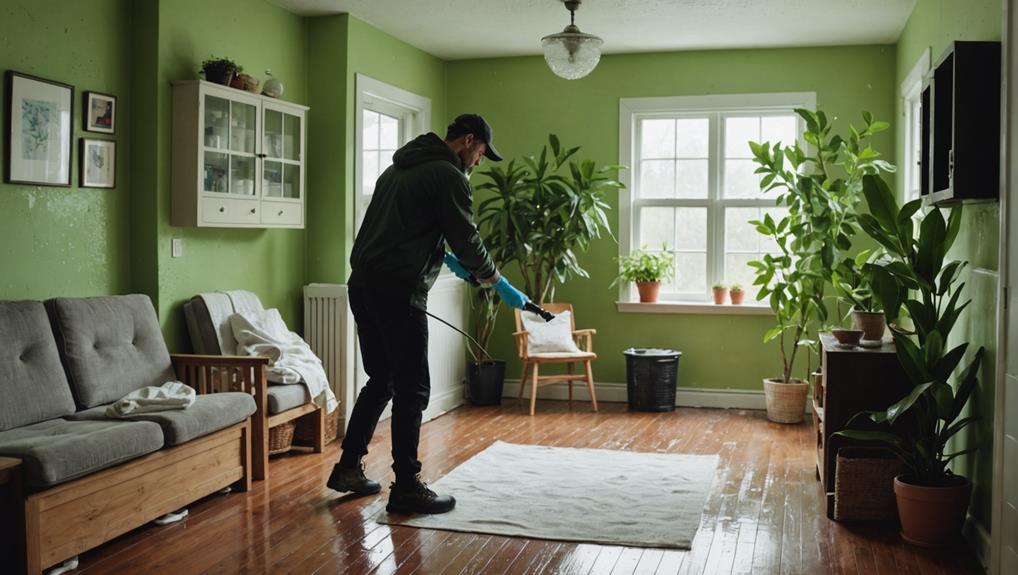To combat mold growth in rainy areas, you need to control moisture and humidity effectively. Keep indoor humidity between 30% and 50% by using dehumidifiers and hygrometers. Guarantee proper ventilation in high-risk areas like kitchens and bathrooms, utilizing both natural airflow and mechanical systems. Regularly inspect areas prone to moisture, sealing any leaks and maintaining gutters to direct water away from your home. Additionally, consider using mold-resistant materials in construction or renovations. Implementing effective cleaning practices, like using antifungal agents, can further minimize mold risks. There are additional strategies worth exploring to enhance your mold prevention efforts.
Understand Mold Growth Conditions
Mold thrives in specific conditions, making understanding these factors important for prevention. Primarily, mold requires moisture to grow, which is why areas with high humidity levels or frequent water exposure are particularly vulnerable. Different mold types—such as Aspergillus, Cladosporium, and Stachybotrys—thrive in varying environments. You should be aware that even small leaks or spills can create the ideal breeding ground for these organisms.
Temperature also plays a notable role; most molds flourish in temperatures between 60°F and 80°F. This means that your home's climate control is critical, especially during rainy seasons when humidity levels typically rise. If you're experiencing persistent moisture issues, it is important to assess where the water is coming from—whether it's from external sources like heavy rains or internal sources like plumbing leaks.
Moreover, the presence of organic materials such as wood, drywall, and fabric serves as a food source for mold. As a result, maintaining cleanliness and promptly addressing any water damage is significant in minimizing mold growth. The health effects of mold exposure can range from mild respiratory issues to severe allergic reactions and toxic responses, depending on the mold type and individual sensitivities. Understanding these growth conditions not only helps in mold prevention but also protects your health and the well-being of your loved ones. By staying vigilant about moisture control and promptly addressing leaks, you can greatly reduce the risk of mold infestations in your home.
Improve Home Ventilation
One effective strategy to combat mold growth is to improve home ventilation. Proper ventilation helps to circulate air, thereby reducing humidity levels that mold thrives on. You can utilize two primary approaches: natural ventilation and mechanical ventilation.
Natural ventilation involves the use of windows, doors, and vents to promote airflow. Opening windows during dry periods allows fresh air to enter and moisture-laden air to escape. However, in rainy climates, this method may not always be dependable. You should consider strategically placing vents in your home to facilitate cross-ventilation, guaranteeing air moves freely throughout living spaces.
On the other hand, mechanical ventilation systems offer a controlled way to manage indoor air quality. These systems can include exhaust fans, range hoods, and whole-house ventilation systems. By actively removing stale air and introducing filtered outdoor air, mechanical ventilation can greatly reduce the chances of mold growth. It's essential to verify that exhaust fans are installed in moisture-heavy areas like bathrooms and kitchens.
Both methods have their merits, but combining them often yields the best results. For instance, using natural ventilation when weather permits, while relying on mechanical systems during periods of increased humidity, can create an ideal environment that discourages mold proliferation.
Ultimately, improving ventilation in your home is a proactive measure that not only enhances air quality but also safeguards your health and property from the adverse effects of mold.
Control Indoor Humidity Levels
Maintaining indoor humidity levels between 30% and 50% is essential for preventing mold growth in your home. High humidity can create an ideal environment for mold spores to thrive, particularly in rainy areas where moisture is prevalent. To effectively control indoor humidity, consider the following strategies:
- Utilize a Dehumidifier: Proper dehumidifier placement is vital. Position it in areas prone to moisture, such as basements or bathrooms, to maximize its efficiency. Make sure to choose a dehumidifier with the appropriate capacity for your space.
- Regular Humidity Monitoring: Invest in a reliable hygrometer to keep track of humidity levels. This tool can help you determine when the humidity is too high, allowing you to take immediate action to mitigate the risk of mold growth.
- Seal Leaks and Gaps: Identify and seal any leaks around windows, doors, and pipes. This not only prevents moisture ingress but also aids in maintaining stable humidity levels indoors.
Regularly Inspect and Maintain
While you might believe that mold growth is solely a consequence of high humidity, regular inspections and maintenance play a essential role in preventing its establishment. To guarantee a mold-free environment, implementing a consistent maintenance schedule is necessary. This proactive approach enables you to identify potential issues before they escalate into considerable problems.
Start by setting aside time for routine inspections of areas prone to moisture, such as basements, attics, and bathrooms. During these inspections, look for signs of mold growth, such as discoloration on walls or ceilings, musty odors, and water stains. Early mold detection is critical; the sooner you spot a problem, the easier and less costly it is to address.
In addition to visual inspections, check your plumbing systems for leaks, as even small drips can contribute to mold development over time. Confirm that your gutters are clean and functioning properly to redirect water away from your home's foundation. This can greatly reduce moisture levels and the potential for mold growth.
Moreover, consider incorporating humidity monitoring devices in your home. Keeping track of indoor humidity can help you maintain ideal levels and inform your maintenance schedule. If you notice consistent high humidity readings, it's time to investigate further and take action.
Use Mold-Resistant Materials
Incorporating mold-resistant materials in your home can considerably reduce the likelihood of mold growth. These materials are specifically designed to withstand moisture, creating an environment that's less conducive to mold development. By investing in these products, you can enhance your home's safety and longevity.
Here are three key types of mold-resistant materials to take into account:
- Mold Resistant Paints: These paints contain antimicrobial agents that inhibit mold growth on surfaces. Applying mold-resistant paint to walls and ceilings, especially in moisture-prone areas like bathrooms and kitchens, can provide an additional line of defense against mold.
- Moisture Barriers: Installing moisture barriers, such as vapor barriers in basements or crawl spaces, helps prevent moisture from penetrating walls and floors. This is vital in rainy areas where ground moisture can seep into your home, creating a breeding ground for mold.
- Mold Resistant Drywall: This specialized drywall is made with moisture-resistant core materials and a fiberglass mat instead of traditional paper. It's particularly beneficial in high-humidity spaces, as it resists both moisture and mold growth effectively.
Implement Effective Cleaning Practices
To effectively combat mold growth, implementing thorough cleaning practices is vital. Regular cleaning helps to minimize moisture and organic material, both of which foster mold proliferation. Start by identifying areas prone to dampness—these are often your bathrooms, kitchens, and basements. Use appropriate cleaning agents that have antifungal properties, such as vinegar, hydrogen peroxide, or commercial mold removers. These not only kill existing mold but also inhibit future growth.
When cleaning, focus on high-risk surfaces like tiles, walls, and carpets. For non-porous surfaces, you can directly apply your chosen cleaning agent, making sure you follow the manufacturer's instructions for safety. Don't forget to wear protective gear, including gloves and masks, to avoid inhalation or skin contact with mold or cleaning chemicals.
After cleaning, consider applying surface treatments designed to prevent mold re-growth. These treatments create a barrier that reduces moisture absorption and helps maintain a dry environment. For porous surfaces, it's essential to guarantee they are adequately dried after cleaning, as trapped moisture can lead to mold resurgence.
In addition, regular maintenance is key. Schedule routine cleanings and inspections to identify and address mold-friendly environments before they become problematic. Keep an eye on humidity levels, ideally maintaining them below 50% through ventilation and dehumidifiers. By combining effective cleaning practices with preventive measures, you'll greatly reduce the risk of mold growth in your home.
Frequently Asked Questions
What Are the Health Effects of Mold Exposure?
Mold exposure can lead to various health effects, particularly if you're sensitive or allergic. You might experience mold symptoms like sneezing, coughing, or itchy eyes. More severe reactions can include respiratory issues, especially in individuals with asthma or other lung conditions. Prolonged exposure may exacerbate these problems, leading to chronic respiratory conditions. It is crucial to monitor your environment and seek ways to minimize exposure for your health and well-being.
How Can I Tell if I Have Mold Hidden in My Home?
To determine if you've got hidden mold in your home, look for common signs: musty odors, water stains, and peeling paint. Employ mold detection methods like visual inspections and moisture meters. Check areas with high humidity, such as basements and bathrooms, for hidden mold signs. If you notice unexplained health issues or increased allergy symptoms, it could indicate mold presence. Staying vigilant can help guarantee your home remains safe and healthy.
Are There Specific Plants That Help Reduce Mold in Indoor Spaces?
Yes, there are specific plants that can help reduce mold in indoor spaces. Air purifying plants, such as spider plants and peace lilies, can improve air quality by absorbing pollutants and increasing oxygen levels. Additionally, humidity-sensitive plants like Boston ferns can help regulate moisture levels, which is essential since mold thrives in damp environments. Incorporating these plants into your home can create a healthier atmosphere and minimize the risk of mold growth.
Can I Use Essential Oils to Prevent Mold Growth?
Yes, you can use essential oils to help prevent mold growth. Essential oil benefits include their antifungal properties, making them effective natural mold remedies. Oils like tea tree, lavender, and eucalyptus have shown promise in combating mold spores. However, it's vital to use them properly; dilute them in water and spray in affected areas. While they can support prevention, they shouldn't replace traditional cleaning methods or professional remediation for significant mold problems.
What Should I Do if Mold Returns After Cleaning?
Imagine a garden where weeds keep reappearing despite your best efforts. If mold returns after cleaning, it's a sign you need to dig deeper. Start by implementing preventive measures like improving ventilation and controlling humidity. If the problem persists, don't hesitate to seek professional assistance. They can identify hidden sources and provide solutions tailored to your situation. Your safety and health deserve meticulous attention, ensuring your space remains mold-free for good.




